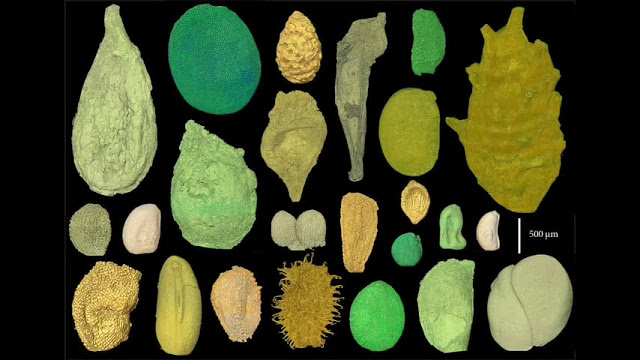
The discovery of exceptionally well-preserved, tiny fossil seeds dating back to the Early Cretaceous corroborates that flowering plants were small opportunistic colonizers at that time, according to a new Yale-led study.
Angiosperms, or flowering plants, diversified during the Early Cretaceous, about 100 to 130 million years ago. Based on evidence from living and fossil plants, the earliest angiosperms are usually thought to have had small stature. New data from the fossil record presented here strongly support this notion, but also indicates key differences from modern flowering plants.
Writing in the journal Nature, a team of researchers reports the discovery of small seed embryos — less than 0.3 millimeters in size — and their surrounding nutrient storage tissues in well-preserved seeds found in eastern North America and Portugal.
The study was led by Else Marie Friis, a professor emerita at the Swedish Museum of Natural History and a Bass Distinguished Visiting Professor at the Yale School of Forestry & Environmental Studies (F&ES). Other authors include Peter Crane, Professor of Botany and Dean of F&ES, Kaj Raunsgaard Pedersen, an Associate Professor Emeritus at the University of Aarhus in Denmark and a Visiting Fellow at F&ES, and two colleagues from the Swiss Light Source, Paul Scherrer Institute, Villigen, Marco Stampanoni and Federica Marone.
Using a visualization technique known as synchrotron radiation X-ray tomographic microscopy — which allows researchers to examine the internal features of delicate fossils in a non-destructive way — the researchers analyzed more than 250 mature seeds encompassing roughly 75 angiosperm taxa, some of which had the seed embryo fully preserved. Their findings show that the embryos are tiny (one-fourth to one-third of a millimeter), with excellent preservation of cell structure.
The minute size of the fossil embryos is consistent with the interpretation that seed dormancy allowed the earliest flowering plants to survive through harsh environmental conditions and colonize disturbance-prone habitats.
The discoveries support the concept that small embryos and seed dormancy are basic for flowering plants as a whole. However, the embryo to seed ratio in the fossil seeds is much smaller than in seeds of most living angiosperms and an order of magnitude smaller than has been hypothesized for the ancestral angiosperm embryo based on studies of living plants.
Seed dormancy would have ensured that the seeds of early angiosperms could survive until conditions for germination and seedling establishment were favorable, Friis said. However, the tiny embryo size and modest nutrient reserves would also have been a constraint on the rapidity with which these early angiosperms could have germinated in response to short-lived moisture availability.
“This is important because it suggests that while early angiosperms may have had many characteristics of modern weedy early colonizers, they would have been unable to match the very rapid germination of the many different kinds of angiosperm herbs that evolved later and that ultimately proved even more effective in exploiting ephemeral ecological opportunities,” Friis said.
Added Crane: “This is the first time that we have had direct fossil evidence of the embryos of early angiosperms and how they compare with those of living plants. These observations have given us critical insights into the early part of the life cycle of early angiosperms, which is important for understanding the ecology of flowering plants during their emergence and dramatic radiation through the Early Cretaceous.”
Video
Reference:
Else Marie Friis, Peter R. Crane, Kaj Raunsgaard Pedersen, Marco Stampanoni, Federica Marone. Exceptional preservation of tiny embryos documents seed dormancy in early angiosperms. Nature, 2015; DOI: 10.1038/nature16441
Note: The above post is reprinted from materials provided by Yale School of Forestry & Environmental Studies.










